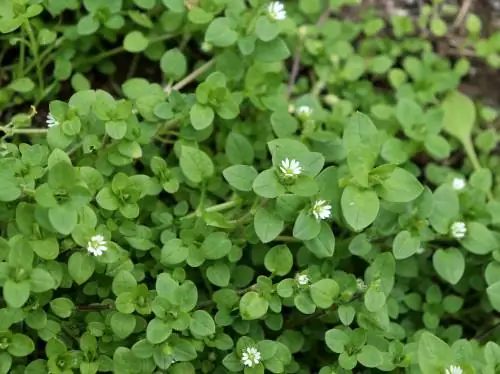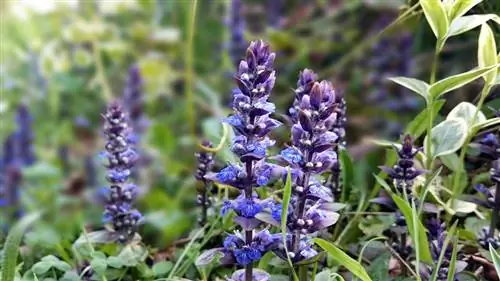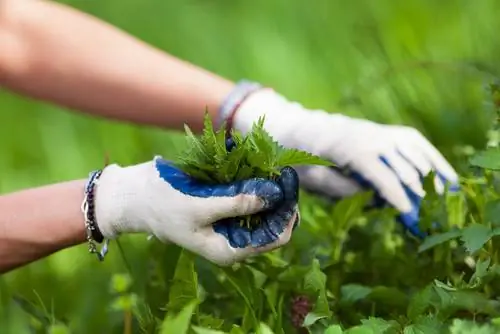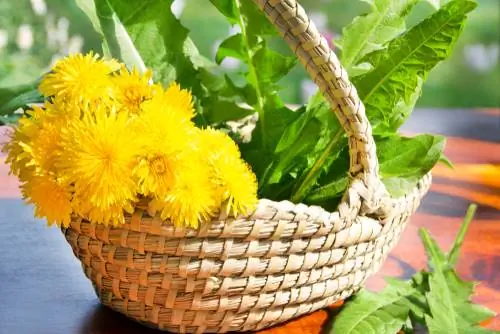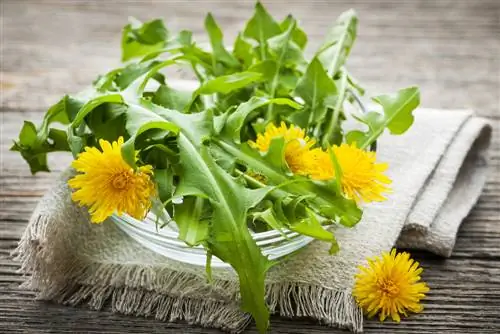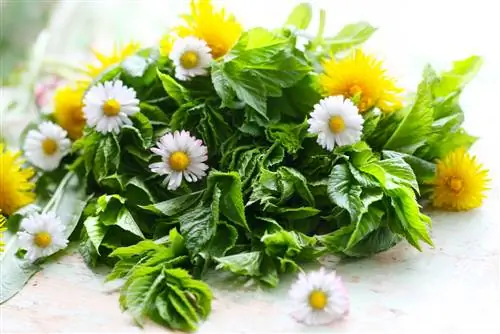- Author admin [email protected].
- Public 2023-12-25 17:45.
- Last modified 2025-01-23 11:21.
Edible wild herbs are in abundance. Hardly anyone really knows anything about it. Let alone reach for it. Wild herbs have more valuable ingredients to offer than most cultivated plants. And almost every one of them has a healing effect. Here is a selection.

Which wild herbs are edible and he althy?
Edible wild herbs such as wild garlic, nettle, French herb, daisies, ground goose, Gundermann, Guter Heinrich, garlic mustard, dandelion, chickweed and woodruff are rich in valuable nutrients and can be used in many ways in the kitchen. When collecting, pay attention to the risk of confusion with poisonous plants.
Wild garlic
It is also called wild garlic. That's how it tastes too. The plant grows to a height of 10 to 40 cm and flowers white from April.
- Location: deciduous and riparian forests
- Usable parts: leaves and flowers
- Collection time: leaves in March and April; Flowers from April to May
Note:There is a risk of confusion with the poisonous lilies of the valley and autumn crocus.
Stinging Nettle
The nettle is one of the most valuable wild herbs we have in this country. It is chock full of he althy ingredients. Nettle tea is ideal for a cleansing treatment in spring.
- Location: along paths, hedges
- Usable parts: leaves and seeds
- Collection time: Leaves from April to June; Seeds from the end of July to October
French herb
French herb is also known as button herb. It used to be sown as a cultivated vegetable, that's how good it tastes. The greens can be used in salads and soups. Seedlings can be grown from seeds.
- Location: wasteland
- Usable parts: leaves and seeds
- Collection time: Leaves from April to September; Seeds from July to October
Daisies
The daisy is one of the first wild herbs in spring. It doesn't always have to be looked for in the distance, as it is also a frequent visitor to gardens.
- Location: meadows and pastures
- Usable parts: leaves and flowers
- Collection time: leaves from March to May; Flowers from March to July
Giersch
The gourd is not particularly appealing at first glance, but it should definitely be tried. Its taste of carrot and parsley goes well with many dishes. It can occasionally be found in the garden with some other wild herbs.
- Location: meadows and pastures, deciduous forests
- Usable parts: leaves and flowers
- Collection time: Leaves from April to May; Flowers from June to August
Gundermann
The Gundermann is very aromatic. But it also has a lot of bitter and tannins. That's why the spicy herb should be dosed modestly.
- Location: meadows and pastures
- Usable parts: leaves
- Collection time: from March to June
Good Henry
Good Henry used to be grown in cottage gardens until it was replaced by spinach. In the meantime, he is regaining his place little by little. But it can still be found in the wild.
- Location: paths and fields
- Usable parts: leaves
- Collection time: from April to June
Tip
You can freeze the leaves of Good Henry for the winter. To do this, the herb must first be blanched briefly.
Garlic mustard
If you can't tolerate the garlic bulb but like the aroma, you can use garlic mustard. Then it's best eaten raw in a salad. This way the spicy taste is fully preserved.
- Location: bushes and forests
- Usable parts: leaves and flowers
- Collection time: Leaves from April to June; Flowers from May to June
Dandelions
The dandelion is edible from flower to root, with the fresh new growth preferred by most collectors. Only pick it from a meadow where small dogs run around and there are no cars nearby. As a wild herb, dandelions often grow in lawns.
- Location: on meadows, along the paths
- Usable parts: leaves, flowers and stems, roots
- Collection time: leaves from March to May; Flowers from April to August; Roots in October
chickweed
Chickweed is the ideal “wild” salad substitute for many wild herb collectors. It is mild and can therefore be combined well with many other salad ingredients.
- Location: bushes, fields, paths
- Usable parts: leaves and flowers
- Collection time: leaves in March and April; Flowers from April to May
Woodruff
The woodruff is not eaten but is tasted and smelled. First it has to wilt after being picked and then give us its aroma.
- Location: deciduous and riparian forests
- Usable parts: leaves and flowers
- Collection time: March to October
Other edible wild herbs
If you collect wild herbs, you might come across the following edible specimens:
Bach speedwell, common barbara, meadow hogweed, common hogweed, common mugwort, mountain mint, beavernelle, loosestrife, meadow longhorn beard, borage, small brownnock, watercress, common dost, marshmallow, angelica, earth chestnut, lamb's lettuce, lady's mantle, common goose thistle, wild goat's beard, creeping goose, small hawkweed, field pennywort, shepherd's purse, coltsfoot, St. John's wort, chamomile, cow parsley, red clover, great burdock, snake knotweed, mullein, cornflower, meadow bedstraw, wild mallow, Orach, wild carrot, clove root, peppercorn, pennigwort, common rain cabbage, meadow sage, sorrel, wood sorrel, field horsetail, yarrow, foamwort, cowslip, field mustard, meadow cranesbill, balsam, deadnettle, violet, ribwort plantain, common chicory, large meadow head,
Tip
Poisonous wild herbs are in the minority, but the risk of confusion should not be underestimated. Find out about the differentiating features in good time.

